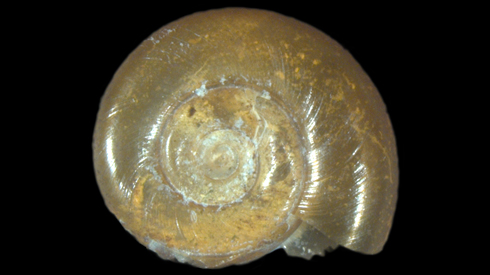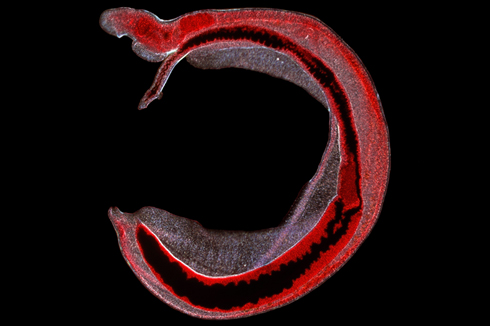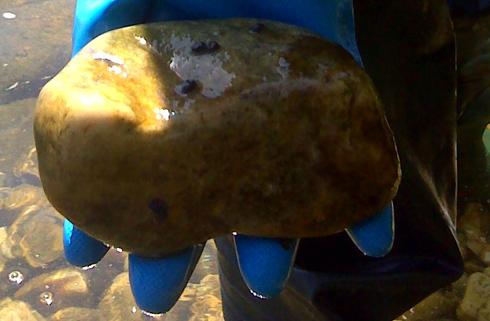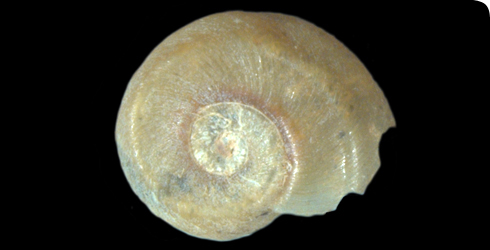Biomphalaria choanomphala
A little snail of very big biomedical importance
Biomphalaria choanomphala is a small, freshwater snail. It is studied by scientists at the Natural History Museum because of its very unique role as a host for the parasite Schistosoma mansoni, which causes a nasty disease in humans called intestinal schistosomiasis, or bilharzia.
Research on these little Biomphalaria choanomphala snails is integral to our efforts to control and treat schistosomiasis.
Species detail

Biomphalaria snails are the intermediate hosts of Schistosoma blood flukes, the parasites that cause schistosomiasis.
Biomphalaria choanomphala belongs to a group of snails called the Planorbidae.
Biomphalaria snails, like other planorbids:
- live in fresh water, relying on air to breathe
- are vegetarians, and are believed to eat aquatic plants and algae
Although their day-to-day behaviour has rarely been observed in detail in the wild, their biomedical importance means populations are often kept in the laboratory and studied close up.
Their main trait of interest is their role as the intermediate host of Schistosoma mansoni.
-

Taxonomy
Although morphological measurements have traditionally been used to identify species of Biomphalaria, new molecular tools are proving very useful in uncovering cryptic diversity. Unfortunately, unravelling the exact taxonomic status of B. choanomphala is proving rather more difficult. Find out more.
-

Biology
Biomphalaria snails are hermaphrodites, capable of self-fertilisation. This abilitiy means they are capable of quickly colonising new locations. Find out more.
-

Distribution
Biomphalaria snails originated in South America but due to their natural dispersal ability have since spread across a further 4 continents. Learn more, including how climate change could help schistosomiasis spread into currently unaffected areas and about Museum research into the population dynamics of B. choanomphala.
-

Disease
Discover more about Biomphalaria's role in the transmission of intestinal schistosomiasis, and how research by Museum scientists aims to help the communities most at risk. Learn about past and future strategies for disease control.
-

References
Reference material relating to Biomphalaria choanomphala, and Biomphalaria more generally.
Images

Shell of Biomphalaria choanomphala. This freshwater snail plays a key role in transmitting schistosomiasis, a parasitic disease that affects humans and other mammals.

Biomphalaria snail shells

Shell of Biomphalaria sudanica, a snail which looks different from B. choanomphala but is very similar genetically.

An illustration of the reproductive structures of Biomphalaria peregrina from Argentina (left) and Biomphalaria choanomphala from East Africa (right). Internal organ shape is often used to help identify Biomphalaria species living in the New World, but it is less useful for identifying the more recently evolved African species. © Taken from labelled drawings by JP Pointier, University of Perpignan

Biomphalaria snails are the intermediate hosts of Schistosoma blood flukes, the parasites that cause schistosomiasis.

Scanning electron microscope image of a Schistosoma flatworm, the parasite that causes schistosomiasis.

Schistosoma blood flukes mating. These parasites cause the disease schistosomiasis in humans and need Biomphalaria snails to be able to complete their life cycle.

People collecting water from Lake Victoria. This scene shows a typical water site where Biomphalaria choanomphala could live - if these snails are infected, people in contact with the water could risk contracting schistosomiasis.

A Biomphalaria snail (indicated by arrow) on a rock that has been lifted out of the shallow pool in the background.

Biomphalaria snails in situ on a rock in Uganda, lifted from the shallow rocky area in the background

Collection of shells of snail species (Bulinus sp. and Biomphalaria sp.) that are intermediate hosts for Schistosoma blood flukes.
About the author

$linktitle
PhD student in the Zoology Department, researching Biomphalaria snails and Schistosoma mansoni human trematode parasites in Lake Victoria.
